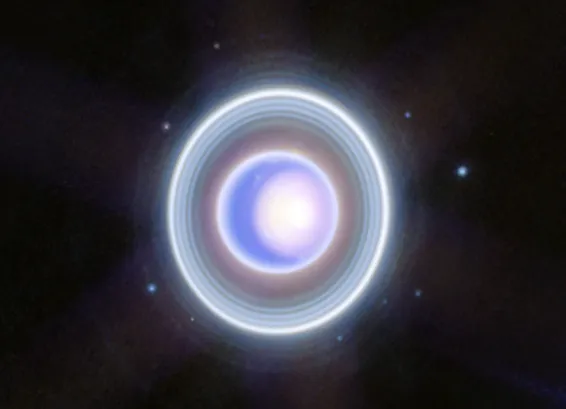James Webb Space Telescope Reveals Unprecedented Details of Uranus
The universe continues to unveil its secrets, thanks to the remarkable capabilities of the James Webb Space Telescope (JWST). A stunning new image, captured by JWST's Near-Infrared Camera (NIRCam), offers an unparalleled close-up view of the ice giant Uranus, revealing intricate details never before seen with such clarity.

A Symphony of Rings and Moons
This breathtaking capture highlights Uranus in a way that truly redefines our understanding of its ethereal beauty. The image exquisitely details the planet's intricate ring system, including its dim inner and outer rings, and even the elusive Zeta ring, which is the closest to the planet. For context, Uranus is known to possess 13 distinct rings.
Beyond the rings, the image also provides a clearer view of several of Uranus's moons. While 27 confirmed moons are known, recent discoveries suggest that number could be as high as 28! These celestial companions, along with the planet's vibrant blue hue, are brought into sharp focus by JWST's advanced optics.
Unveiling the Polar Cap and Unique Characteristics
One of the most striking features visible in this new image is Uranus's seasonal north polar cap. This distinct structure is clearly highlighted, showing both its bright, white inner region and a darker lane situated at its bottom. This level of detail offers scientists invaluable data for studying the planet's atmospheric dynamics and seasonal changes.
Uranus, often playfully referred to due to its name, is an ice giant approximately four times the diameter of Earth. Its distinctive blue-green color is primarily due to methane in its atmosphere, which absorbs red light. What makes Uranus truly unique is its extreme axial tilt, causing it to essentially orbit the Sun on its side, leading to highly unusual seasons. To put its size into perspective, approximately 63 Earths could comfortably fit inside Uranus.
Seeing Beyond the Visible Spectrum
It's important to note that this image, captured by JWST's NIRCam, is taken in the near-infrared spectrum. This means it reveals features that are not visible to the naked human eye. If you were to observe Uranus with a conventional telescope, it would appear far dimmer and less vibrant than this stunning JWST rendition. Images like those captured by the Voyager 2 probe in 1986 provide a more "naked-eye" equivalent view, highlighting the incredible leap in observational technology represented by JWST.
The Future of Planetary Science
This image is yet another testament to the James Webb Space Telescope's unparalleled capabilities. By observing our solar system's distant giants in new wavelengths, JWST is continuously expanding our knowledge, pushing the boundaries of discovery, and offering unprecedented insights into the mysteries of our cosmic neighborhood. What other wonders will it reveal next? Stay tuned!




